Pop-ups are annoying, aren’t they? Here’s the thing, though — they also convert like crazy.
If your client doesn’t use them, chances are they are ill-prepared for the holiday season. Today, let’s try to fix this problem with some creative strategies that take the usual annoying overlay and make it into a customer acquisition magnet.
You might also like: 6 Tricks to Increase Your Clients' Conversion Before Christmas
1. Incentivize opt-ins for first-time visitors
All too often your client’s welcome emails waste a valuable opportunity to engage and convert a first-time signup. To remedy that, you need to suggest a whole new approach to interacting with first-time visitors.
For instance, instead of simply welcoming a first-time customer to the website, create a behavioral email that will present them with their most recent purchase along with suggestions of related items that pair nicely with it.
Alternatively, if your client is trying to sign up leads as opposed to new buyers, you can send them a discount code in a welcome email along with suggestions of best-selling products to use it on.
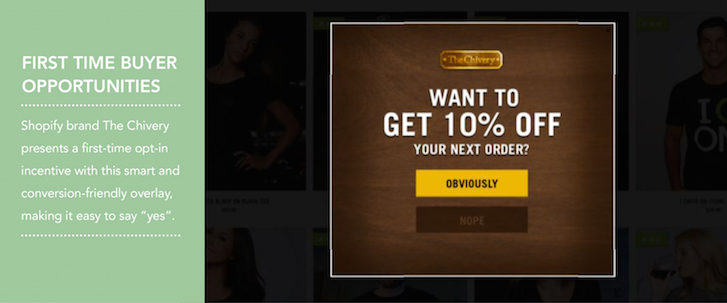
Why this works: As opposed to just telling their customers something, your client will be offering them an opportunity to take action. Most inbound visitors will already be in a buying mood, so a discount could be exactly what it takes to incentivize them to purchase.
How to do this: There are a variety of existing Shopify Apps that you can use to create an overlay like this, like JustUno or Privy. And to create an actual welcome email with a personalized discount, you can use Klaviyo.
Hint: You can also experiment and offer “real-money” credit towards a customer’s purchase, instead of “X per cent off”. Depending on your client’s target audience, this can work better than a percentage-based discount. According to research, 31% of coupon users are most interested in deals that offer a specific dollar amount off their purchase. A store credit is something that is more tangible and straightforward for customers instead of a percentage discount. To see what style of offer resonates the most with your client's audience, try running a simple A/B test.
2. Prevent cart abandonment with exit-intent overlays
Interestingly, you can use exit-intent overlays to prevent customers from abandoning your client’s cart mid-purchase. Thanks to its immediacy, this strategy will shorten the time it takes for a visitor to become a customer, or repeat customer.
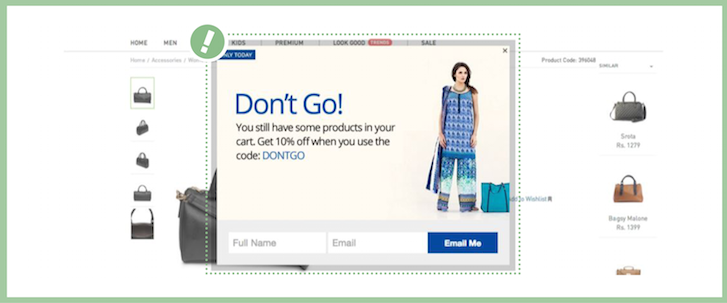
Why this works: According to Statista, shopping cart abandonment rates in 2014 were 72.43%. This stat should be shocking to any ecommerce designer, but it also indicates that you might want to spend more time adding features to your online shopping cart to retain customers.
How to do this: Shopify’s checkout page doesn’t let the regular customer make edits to the code, but there are built-in settings that can work such as social login for account creations to reduce customer checkout time and apps for exit-intent overlays.
Hint: The Exit Offers and Picreel apps available through the Shopify App Store can help you add exit-intent overlays to your online store.
3. Use overlays to present personalized offers
According to a recent survey by MyBuy, 48% of consumers exposed to personalized ecommerce messages then proceed to spend more.
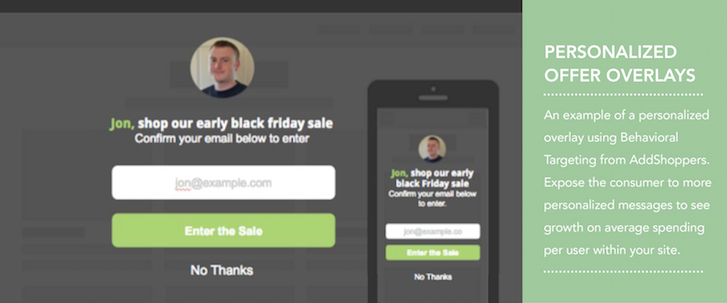
Why this works: Your client’s overlays don’t have to have generic messaging, but can instead leverage the power of customer analytics to create powerful, persuasive messages geared towards a specific customer.
How to do this: By showing the right campaign, to the right person, at the right time.
Hint: Here are just some of the ways behavioral targeted popups from the AddShoppers Shopify app can be triggered:
- On Entrance: welcome customers to your store with exclusive, dynamic incentives to engage.
- On Close: show a deeper discount or offer to customers when they go to close your websites tab/window in their browser.
- Dynamic Top Bar: show a dynamic, targeted offer in the header of your website.
- Customized: Get creative and find new ways to target site visitors.
You might also like: 5 Shopify Store Design Elements to Maximize Holiday ROI
4. Embrace scarcity and urgency messaging
Urgency and scarcity are of utmost importance during holiday season. Constant high-pressure discounts are surely evil and damaging to your client’s business long-term, but during the holidays… it’s a different story.
Scarcity and urgency, when they are not overused to the point of becoming pointless, can drive your client’s holiday sales through the roof. You just need to work with them to discover which types of scarcity- or urgency-based messages will make the most sense for their audience.
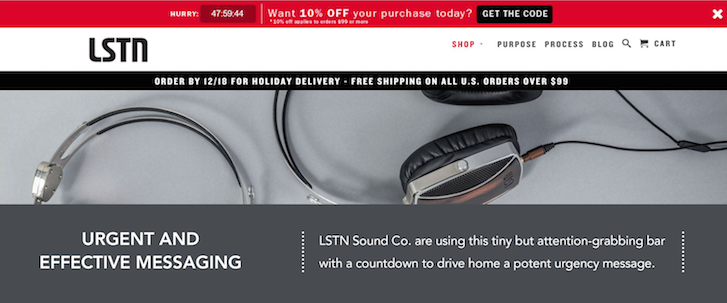
Why this works: Store credits/discounts, temporary sales offers, and just frenzied shopping in general is at an all-time high during the holiday season. Make sure your client's online store capitalizes from it. “Last chance sales” might seem gimmicky at first, but they create the perfect amount of urgency to get visitors buying.
How to do this: Be aware of important holidays and dates for shoppers during the holiday season (such as shipping deadlines, etc.) and offer your customers “limited time offers” around these dates. By explicitly making shoppers aware of such offers through your client's store’s online holiday marketing campaign, you'll increase the odds their take advantage of them.
Hint: Here are some more examples you and your client can explore:
- “Stock clearance” kind of message — where desired items will be gone for a while after a certain point.
- “Gone forever” scarcity message — which exploits customers’ fear of missing out to the fullest. “Hurry up, only X items left - and then we won’t be making them anymore!”
- “Timed free shipping” offer — which is ideal when your client’s average order volume is big, but they don’t typically offer free shipping.
- “Timed discount” offer — which is self-explanatory (see the screenshot above).
5. Use overlays to encourage social sharing
Asking someone to buy is a big request. But after they’ve purchased, they are more inclined to accept another request from your client's brand. Think of this as a reverse foot-in-the-door technique.
There are numerous reasons why people share what they bought on social media, but most of them involve bragging rights and looking good in front of their peers. If your client’s products communicate exactly that, why not capitalize on it with some well-placed purchase sharing calls to action?
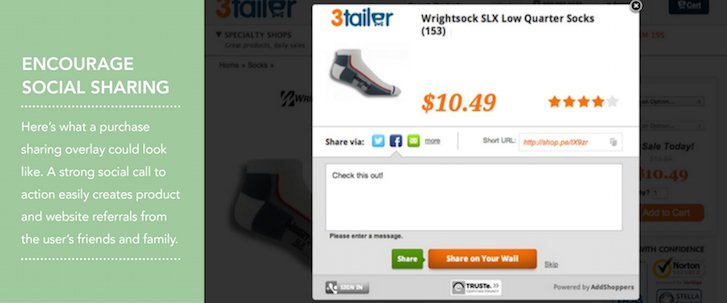
Why this works: Product referrals from a friend or loved one work great for getting your client's store new customers.
How to do this: Try to create a sense of envy around your products, especially on high browsing platforms. If there’s something you often see people doing on mobile, it’s browsing social media. A great Shopify app that can help you take advantage of this is the WANT Button App. By integrating it on your client's store, you'll have the functionality to allow holiday shoppers to browse and add inventory to their ‘wish lists’, all the while increasing your social media presence.
Hint: You can also use a social sharing overlay to give an exclusive discount to a potential customer, but be careful not to overuse it or risk letting too many customers receive discounts.
Start overlays the smart way
Overlays are the UX equivalent of herbs and spices. When used well, they can turn shopping on your client’s website into an amazing experience. When overused, or used poorly, they just leave a bad taste in your mouth. I hope that these five strategies will give you lots of creative ideas for boosting your client’s conversion rates, making their customers happier, and crushing the holiday revenue goals. Enjoy!
Read more
- 3 Steps to Maximize Your Client’s Holiday Revenue Before 2016
- PODCAST: How You & Your Clients Can Make the Most of the Holiday Season
- 6 Ways to Help Merchants Make More Sales This Black Friday/Cyber Monday
- 5 Ways to Prepare Your Clients for Black Friday
- How To Create PPC Campaigns For Your Clients' Holiday Shopify Stores
- Holiday Reading List: The Top 10 Stories of 2015 from Shopify Partners
- 12 Days of Ecommerce: How to Prep Your Client’s Shopify Store for Black Friday
- How to Support Your Clients Over the Holidays
You might also like: Holiday Buyer Psychology — 5 Things You and Your Clients Need to Know

